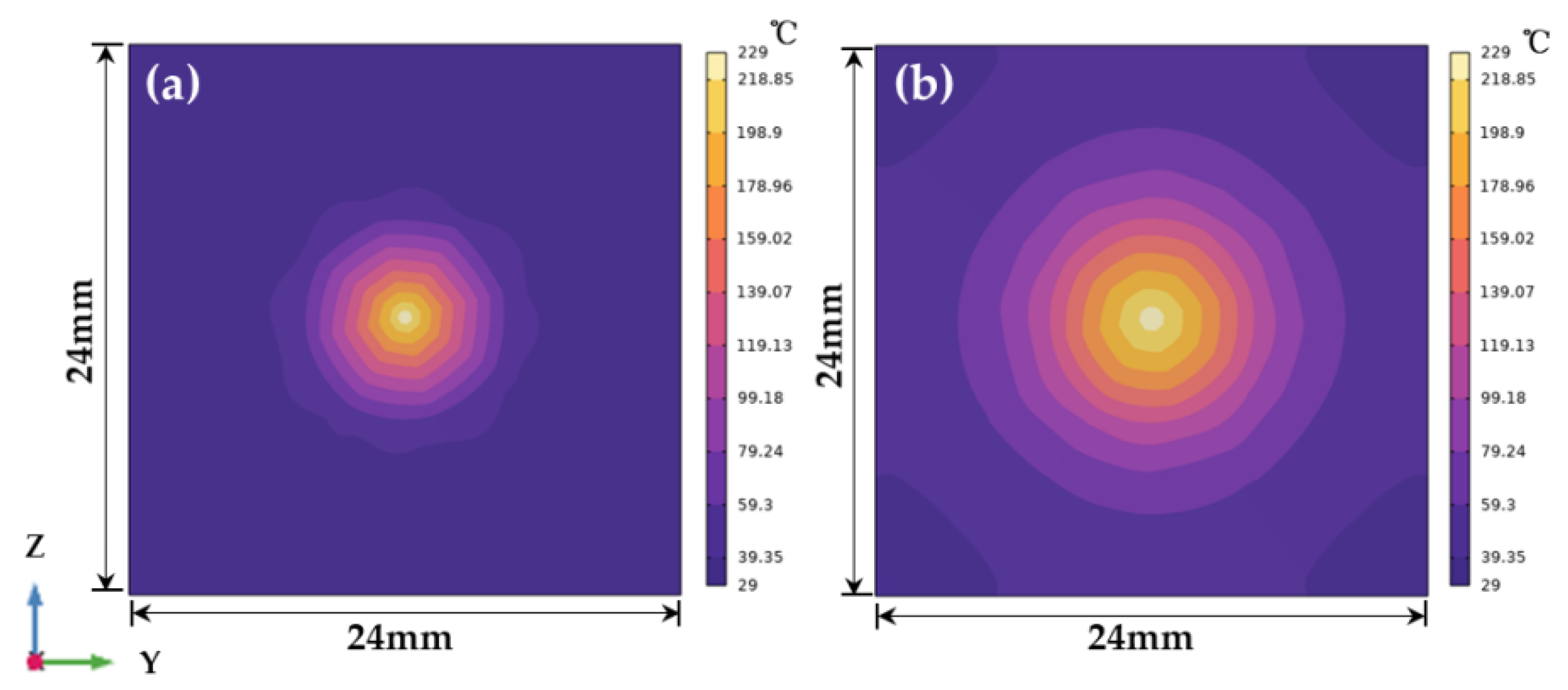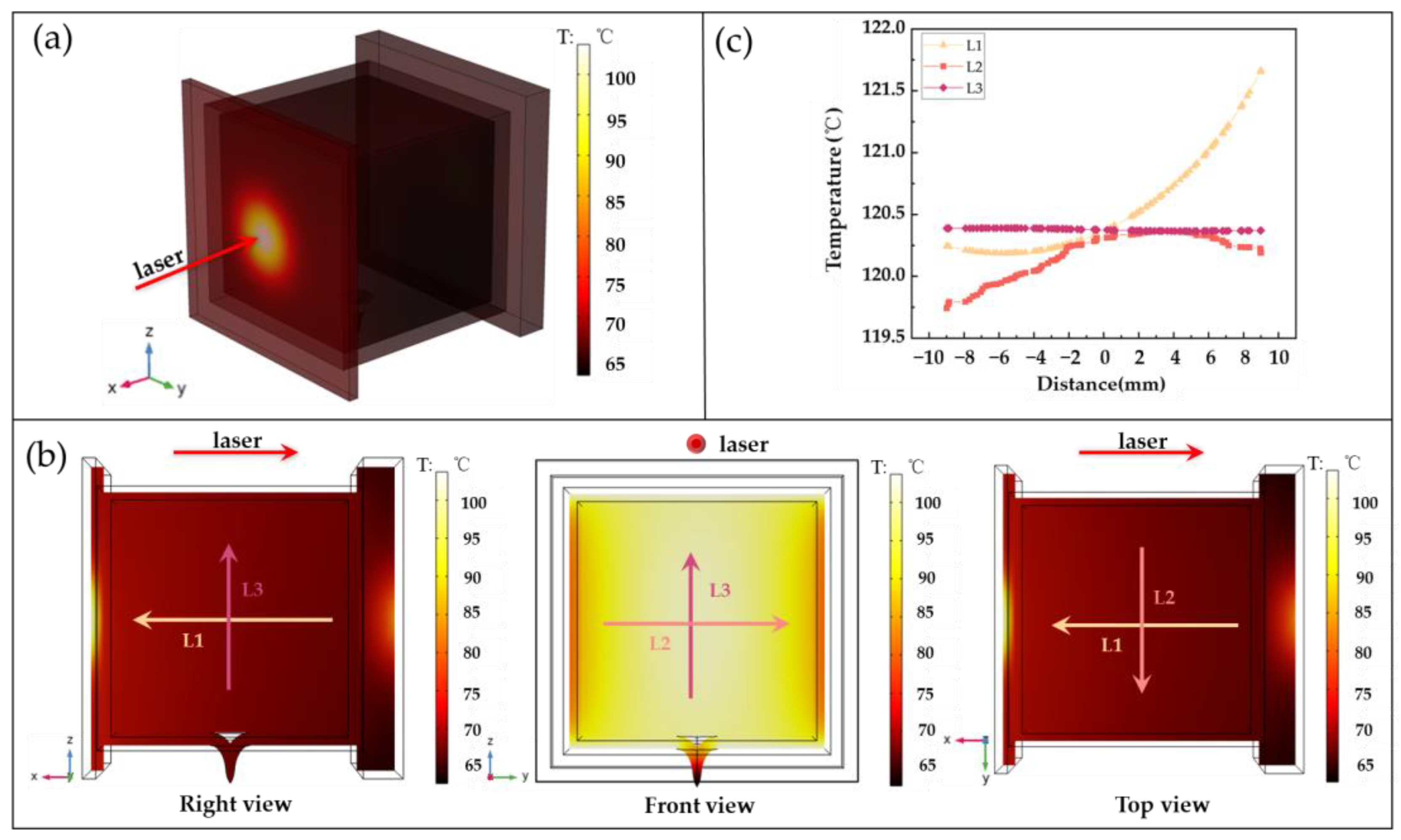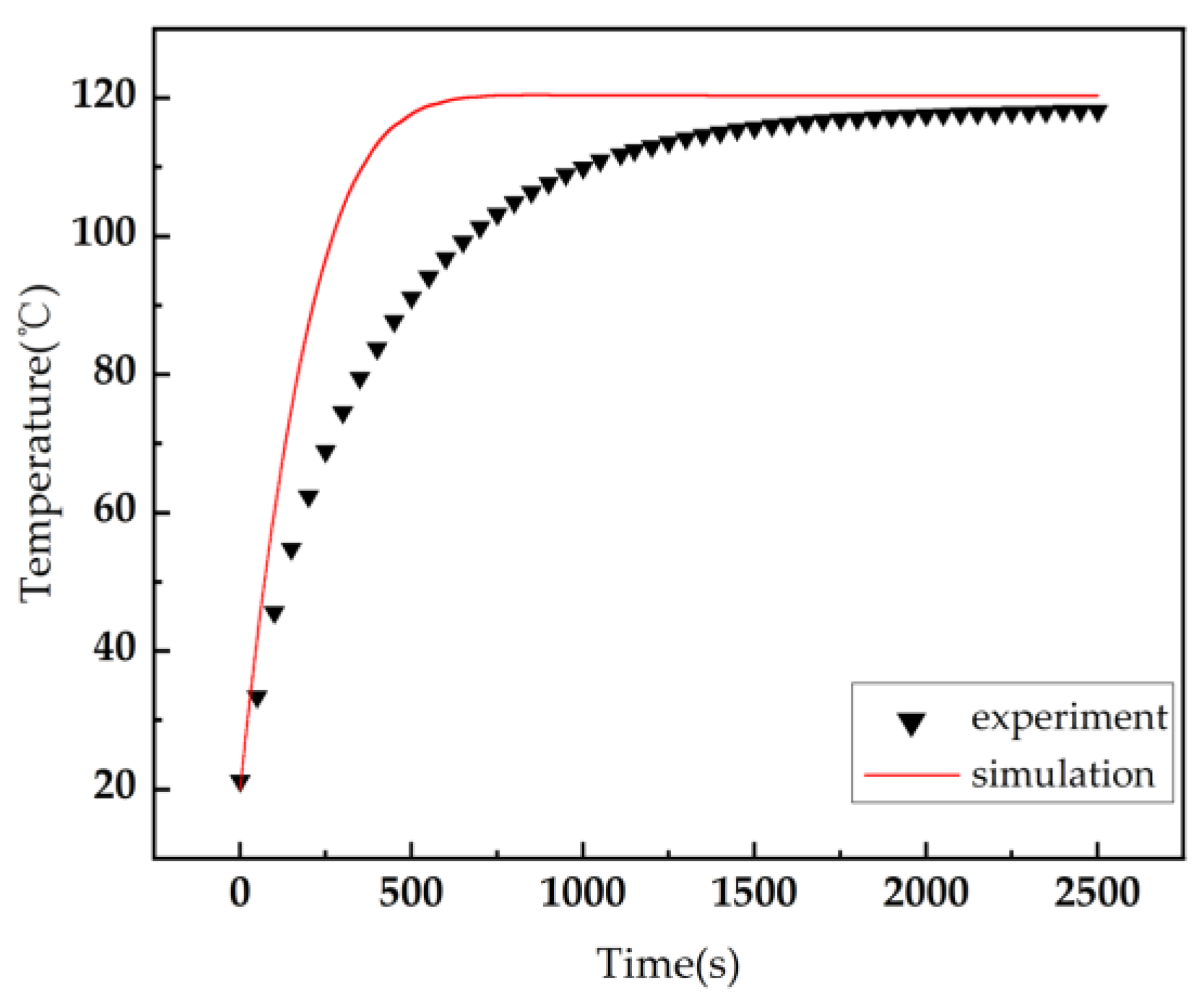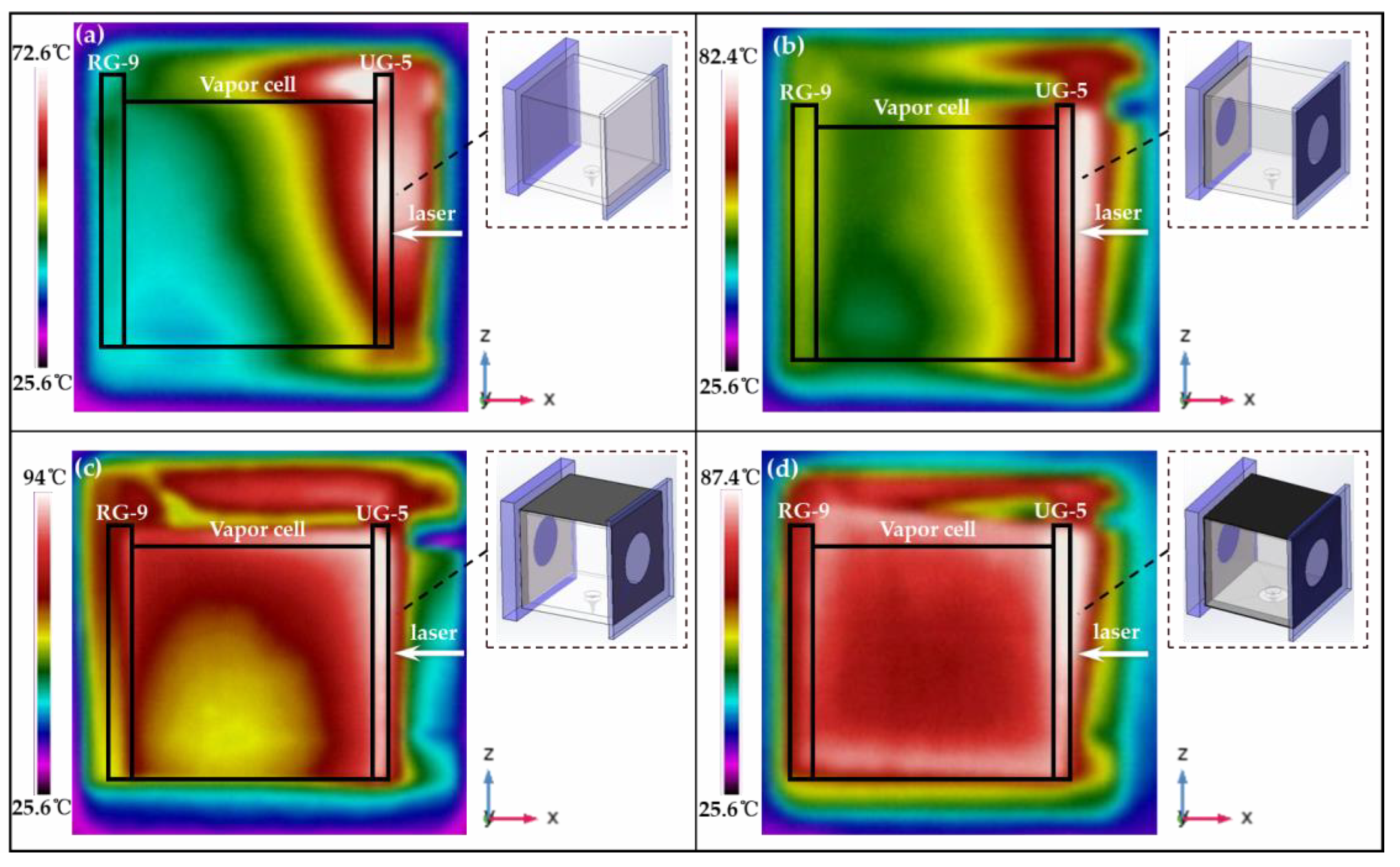Laser Heating Method for an Alkali Metal Atomic Cell with Heat Transfer Enhancement
Abstract
:1. Introduction
2. Analysis and Simulation Methods
2.1. Heat Transfer Analysis
2.2. Finite Element Analysis
3. Experimental Setup
4. Results and Discussion
4.1. Simulated Results
4.2. Experiments
5. Conclusions
Author Contributions
Funding
Institutional Review Board Statement
Informed Consent Statement
Data Availability Statement
Conflicts of Interest
References
- Boto, E.; Meyer, S.S.; Shah, V.; Alem, O.; Knappe, S.; Kruger, P.; Fromhold, T.M.; Lim, M.; Glover, P.M.; Morris, P.G.; et al. A new generation of magnetoencephalography: Room temperature measurements using optically-pumped magnetometers. Neuroimage 2017, 149, 404–414. [Google Scholar] [CrossRef]
- Boto, E.; Holmes, N.; Leggett, J.; Roberts, G.; Shah, V.; Meyer, S.S.; Munoz, L.D.; Mullinger, K.J.; Tierney, T.M.; Bestmann, S.; et al. Moving magnetoencephalography towards real-world applications with a wearable system. Nature 2018, 555, 657–661. [Google Scholar] [CrossRef] [PubMed]
- Zhang, G.Y.; Huang, S.J.; Xu, F.X.; Hu, Z.H.; Lin, Q. Multi-channel spin exchange relaxation free magnetometer towards two-dimensional vector magnetoencephalography. Opt. Express 2019, 27, 597–607. [Google Scholar] [CrossRef]
- Hill, R.M.; Boto, E.; Holmes, N.; Hartley, C.; Seedat, Z.A.; Leggett, J.; Roberts, G.; Shah, V.; Tierney, T.M.; Woolrich, M.W.; et al. A tool for functional brain imaging with lifespan compliance. Nat. Commun. 2019, 10, 4785. [Google Scholar] [CrossRef]
- Wyllie, R.; Kauer, M.; Smetana, G.S.; Wakai, R.T.; Walker, T.G. Magnetocardiography with a modular spin-exchange relaxation-free atomic magnetometer array. Phys. Med. Biol. 2012, 57, 2619. [Google Scholar] [CrossRef]
- Alem, O.; Sander, T.H.; Mhaskar, R.; LeBlanc, J.; Eswaran, H.; Steinhoff, U.; Okada, Y.; Kitching, J.; Trahms, L.; Knappe, S. Fetal magnetocardiography measurements with an array of microfabricated optically pumped magnetometers. Phys. Med. Biol. 2015, 60, 4797–4811. [Google Scholar] [CrossRef]
- Jensen, K.; Skarsfeldt, M.A.; Staerkind, H.; Arnbak, J.; Balabas, M.V.; Olesen, S.P.; Bentzen, B.H.; Polzik, E.S. Magnetocardiography on an isolated animal heart with a room-temperature optically pumped magnetometer. Sci. Rep. 2018, 8, 16218. [Google Scholar] [CrossRef]
- Perry, A.R.; Bulatowicz, M.D.; Larsen, M.; Walker, T.G.; Wyllie, R. All-optical intrinsic atomic gradiometer with sub-20 fT/cm/root Hz sensitivity in a 22 mu T earth-scale magnetic field. Opt. Express 2020, 28, 36696–36705. [Google Scholar] [CrossRef]
- Dang, H.B.; Maloof, A.C.; Romalis, M.V. Ultrahigh sensitivity magnetic field and magnetization measurements with an atomic magnetometer. Appl. Phys. Lett. 2010, 97, 151110. [Google Scholar] [CrossRef]
- Ito, Y.; Sato, D.; Kamada, K.; Kobayashi, T. Optimal densities of alkali metal atoms in an optically pumped K-Rb hybrid atomic magnetometer considering the spatial distribution of spin polarization. Opt. Express 2016, 24, 15391–15402. [Google Scholar] [CrossRef] [PubMed]
- Huang, Q.; Xiang, K.; Huang, Z.J.; Sun, W.M.; Zhang, J.H. A non-magnetic temperature controlling system applied in atomic magnetometer. Adv. Mat. Res. 2013, 760–762, 896–900. [Google Scholar] [CrossRef]
- Liu, G.B.; Li, X.F.; Sun, X.P.; Feng, J.W.; Ye, C.H.; Zhou, X. Ultralow field NMR spectrometer with an atomic magnetometer near room temperature. J. Magn. Reson. 2013, 237, 158–163. [Google Scholar] [CrossRef] [PubMed]
- Jiang, Q.Y.; Luo, H.; Zhan, X.; Zhang, Y.; Yang, K.Y.; Wang, Z.G. Avoiding the impact of the heater-induced longitudinal field on atomic magnetometers. J. Appl. Phys. 2018, 124, 244501. [Google Scholar] [CrossRef]
- Liang, X.Y.; Liu, Z.C.; Die, H.; Wu, W.F.; Jia, Y.C.; Fang, J.C. MEMS Non-Magnetic Electric Heating Chip for Spin-Exchange-Relaxation-Free (SERF) Magnetometer. IEEE Access 2019, 7, 88461–88471. [Google Scholar]
- Lu, J.X.; Wang, J.; Yang, K.; Zhao, J.P.; Quan, W.; Han, B.C.; Ding, M. In-Situ Measurement of Electrical-Heating-Induced Magnetic Field for an Atomic Magnetometer. Sensors 2020, 20, 1826. [Google Scholar] [CrossRef]
- Schwindt, P.D.D.; Lindseth, B.; Knappe, S.; Shah, V.; Kitching, J.; Liew, L.A. Chip-scale atomic magnetometer with improved sensitivity by use of the M-x technique. Appl. Phys. Lett. 2007, 90, 081102. [Google Scholar] [CrossRef]
- Allred, J.C.; Lyman, R.N.; Kornack, T.W.; Romalis, M.V. High-sensitivity atomic magnetometer unaffected by spin-exchange relaxation. Phys. Rev. Lett. 2002, 89, 130801. [Google Scholar] [CrossRef]
- Kominis, I.K.; Kornack, T.W.; Allred, J.C.; Romalis, M.V. A subfemtotesla multichannel atomic magnetometer. Nature 2003, 422, 596–599. [Google Scholar] [CrossRef] [PubMed]
- Preusser, J.; Gerginov, V.; Knappe, S.; Kitching, J. A microfabricated photonic magnetometer. In Proceedings of the 2008 IEEE Sensors, Lecce, Italy, 26–29 October 2008; pp. 344–346. [Google Scholar]
- Alem, O.; Mhaskar, R.; Jimenez-Martinez, R.; Sheng, D.; LeBlanc, J.; Trahms, L.; Sander, T.; Kitching, J.; Knappe, S. Magnetic field imaging with microfabricated optically-pumped magnetometers. Opt. Express 2017, 25, 7849–7858. [Google Scholar] [CrossRef]
- Oelsner, G.; Schultze, V.; Ijsselsteijn, R.; Wittkamper, F.; Stolz, R. Sources of heading errors in optically pumped magnetometers operated in the Earth’s magnetic field. Phys. Rev. A 2019, 99, 013420. [Google Scholar] [CrossRef]
- Savukov, I.; Boshier, M.G. A High-Sensitivity Tunable Two-Beam Fiber-Coupled High-Density Magnetometer with Laser Heating. Sensors 2016, 16, 1691. [Google Scholar] [CrossRef] [PubMed]
- Preusser, J.; Knappe, S.; Kitching, J.; Gerginov, V. A microfabricated photonic magnetometer. In Proceedings of the 2009 Joint Meeting of the European Frequency and Time Forum and the IEEE International Frequency Control Symposium, VOLS 1 and 2, Besancon, France, 20–24 April 2009; pp. 1180–1182. [Google Scholar]
- Mhaskar, R.; Knappe, S.; Kitching, J. A low-power, high-sensitivity micromachined optical magnetometer. Appl. Phys. Lett. 2012, 101, 241105. [Google Scholar] [CrossRef]
- Sheng, D.; Perry, A.R.; Krzyzewski, S.P.; Geller, S.; Kitching, J.; Knappe, S. A microfabricated optically-pumped magnetic gradiometer. Appl. Phys. Lett. 2017, 110, 031106. [Google Scholar] [CrossRef]
- Puri, P.; Jordan, P.M. Wave structure in Stokes’ second problem for a dipolar fluid with nonclassical heat conduction. Acta Mech. 1999, 133, 145–160. [Google Scholar] [CrossRef]
- Nika, D.L.; Balandin, A.A. Phonons and thermal transport in graphene and graphene-based materials. Rep. Prog. Phys. 2017, 80, 036502. [Google Scholar] [CrossRef]
- Cao, H.Y.; Guo, Z.X.; Xiang, H.J.; Gong, X.G. Layer and size dependence of thermal conductivity in multilayer graphene nanoribbons. Phys. Lett. A 2012, 376, 525–528. [Google Scholar] [CrossRef]
- Gill-Comeau, M.; Lewis, L.J. Heat conductivity in graphene and related materials: A time-domain modal analysis. Phys. Rev. B 2015, 92, 195404. [Google Scholar] [CrossRef]
- Vora, H.D.; Santhanakrishnan, S.; Harimkar, S.P.; Boetcher, S.K.S.; Dahotre, N.B. One-dimensional multipulse laser machining of structural alumina: Evolution of surface topography. Int. J. Adv. Manuf. Tech. 2013, 68, 69–83. [Google Scholar] [CrossRef]







| Size | CVT |
|---|---|
| 0 | 0.1308 |
| 20 mm × 20 mm (two pieces) | 0.1038 |
| 20 mm × 60 mm | 0.0697 |
| 20 mm × 80 mm | 0.0426 |
Disclaimer/Publisher’s Note: The statements, opinions and data contained in all publications are solely those of the individual author(s) and contributor(s) and not of MDPI and/or the editor(s). MDPI and/or the editor(s) disclaim responsibility for any injury to people or property resulting from any ideas, methods, instructions or products referred to in the content. |
© 2023 by the authors. Licensee MDPI, Basel, Switzerland. This article is an open access article distributed under the terms and conditions of the Creative Commons Attribution (CC BY) license (https://creativecommons.org/licenses/by/4.0/).
Share and Cite
Li, Y.; Zhou, G.; Tian, S.; Liu, X.; Dong, X.; Gao, X. Laser Heating Method for an Alkali Metal Atomic Cell with Heat Transfer Enhancement. Photonics 2023, 10, 637. https://doi.org/10.3390/photonics10060637
Li Y, Zhou G, Tian S, Liu X, Dong X, Gao X. Laser Heating Method for an Alkali Metal Atomic Cell with Heat Transfer Enhancement. Photonics. 2023; 10(6):637. https://doi.org/10.3390/photonics10060637
Chicago/Turabian StyleLi, Yang, Guoqing Zhou, Shencheng Tian, Xuejing Liu, Xiangmei Dong, and Xiumin Gao. 2023. "Laser Heating Method for an Alkali Metal Atomic Cell with Heat Transfer Enhancement" Photonics 10, no. 6: 637. https://doi.org/10.3390/photonics10060637




